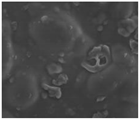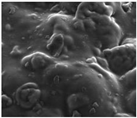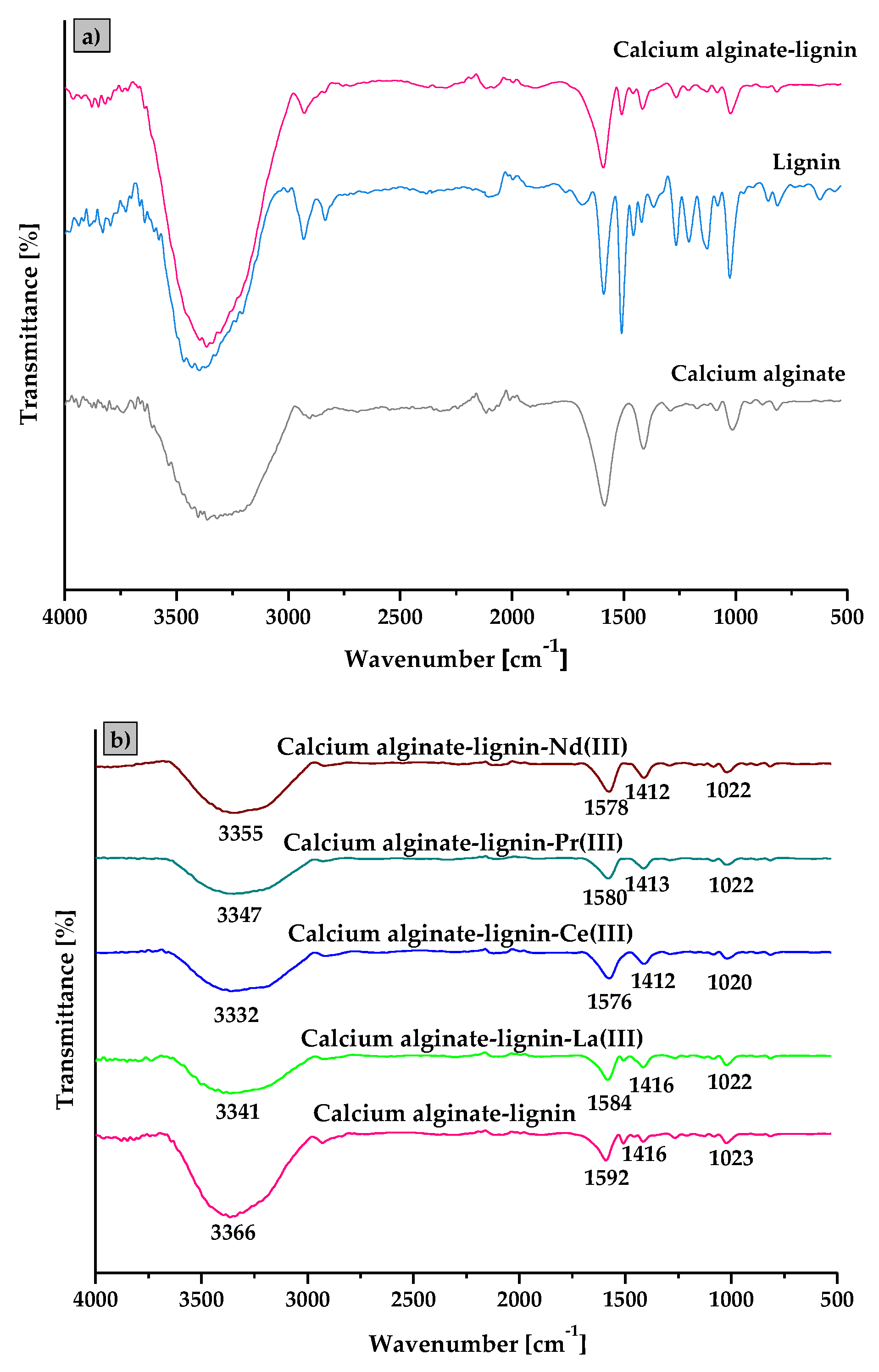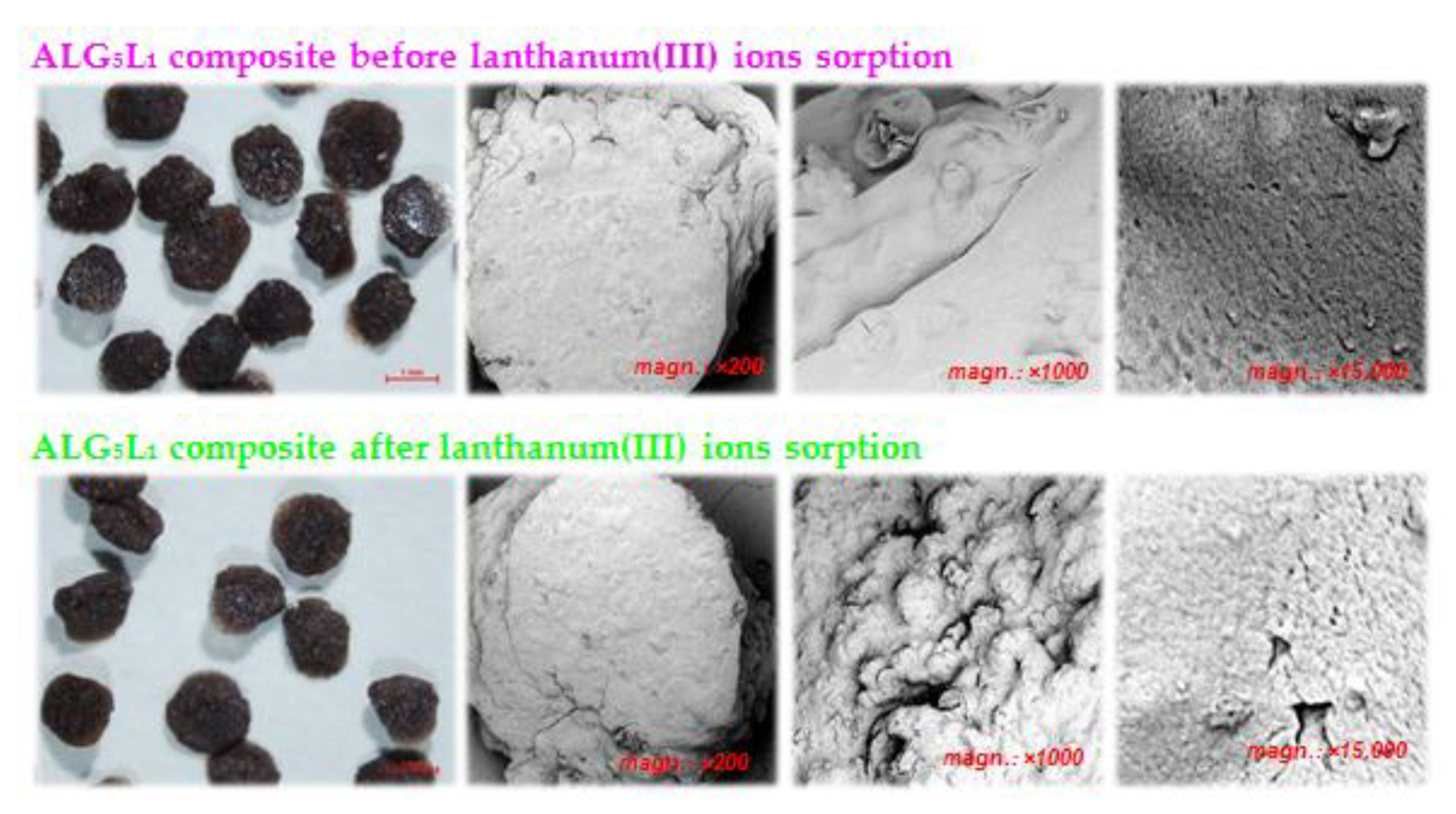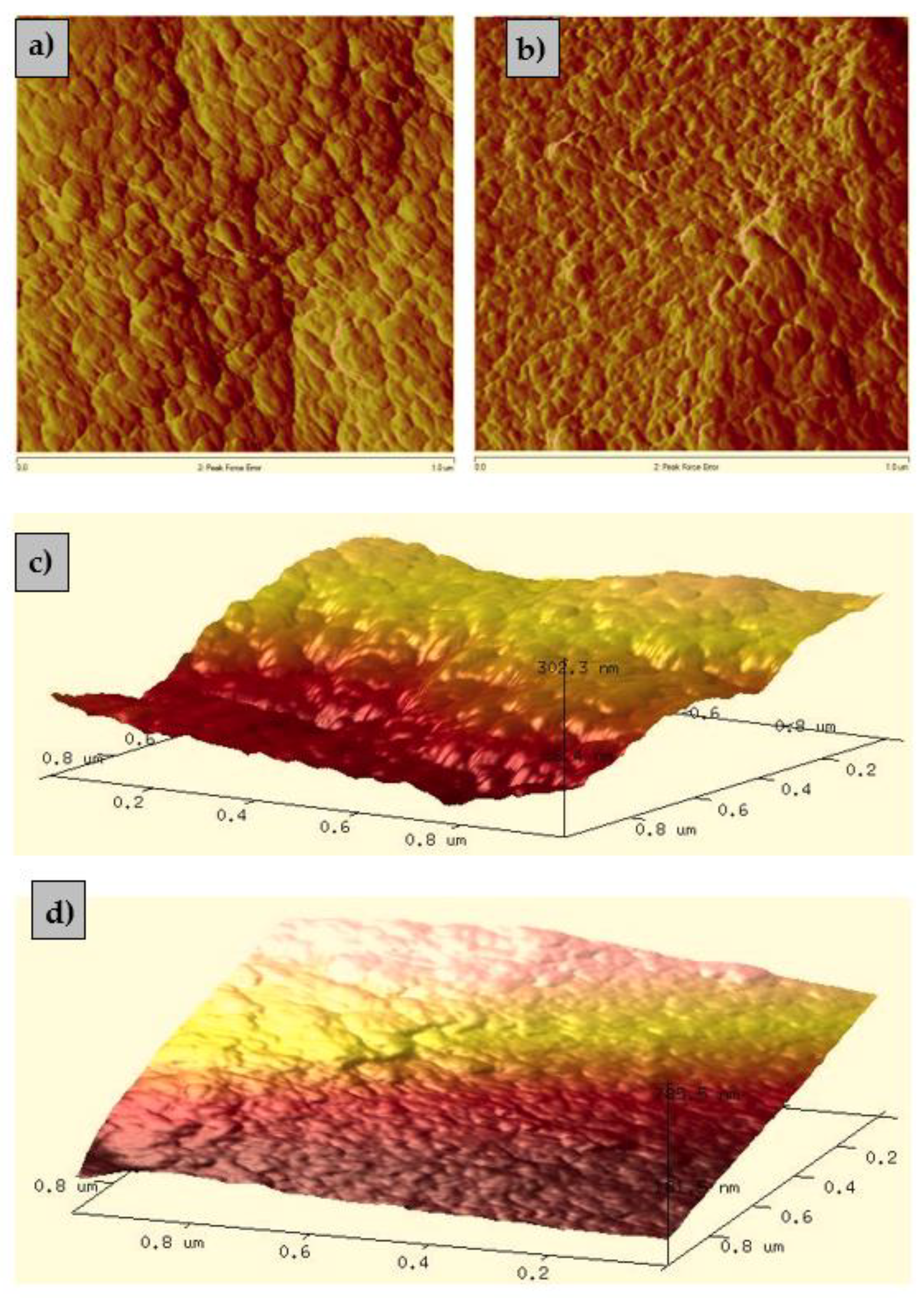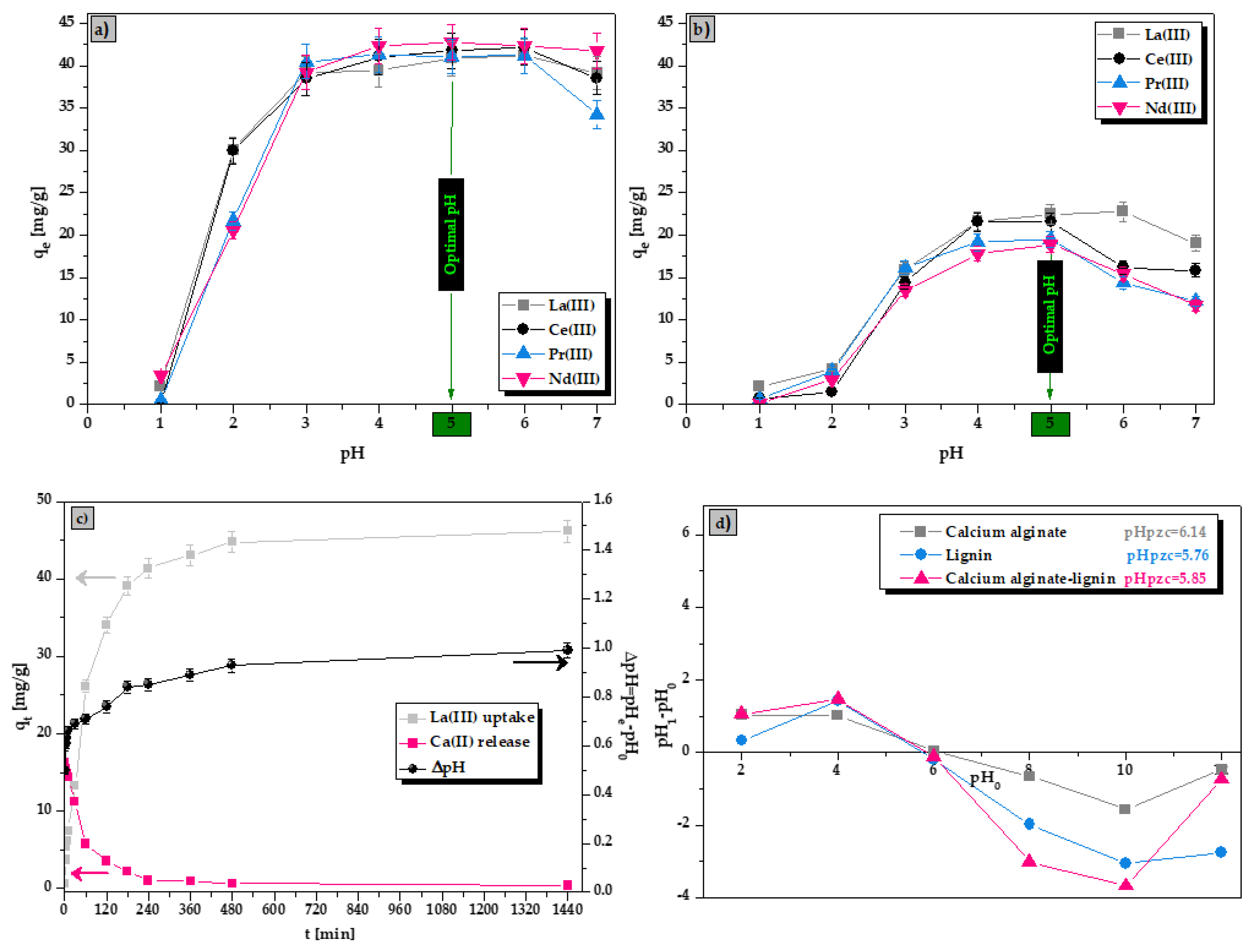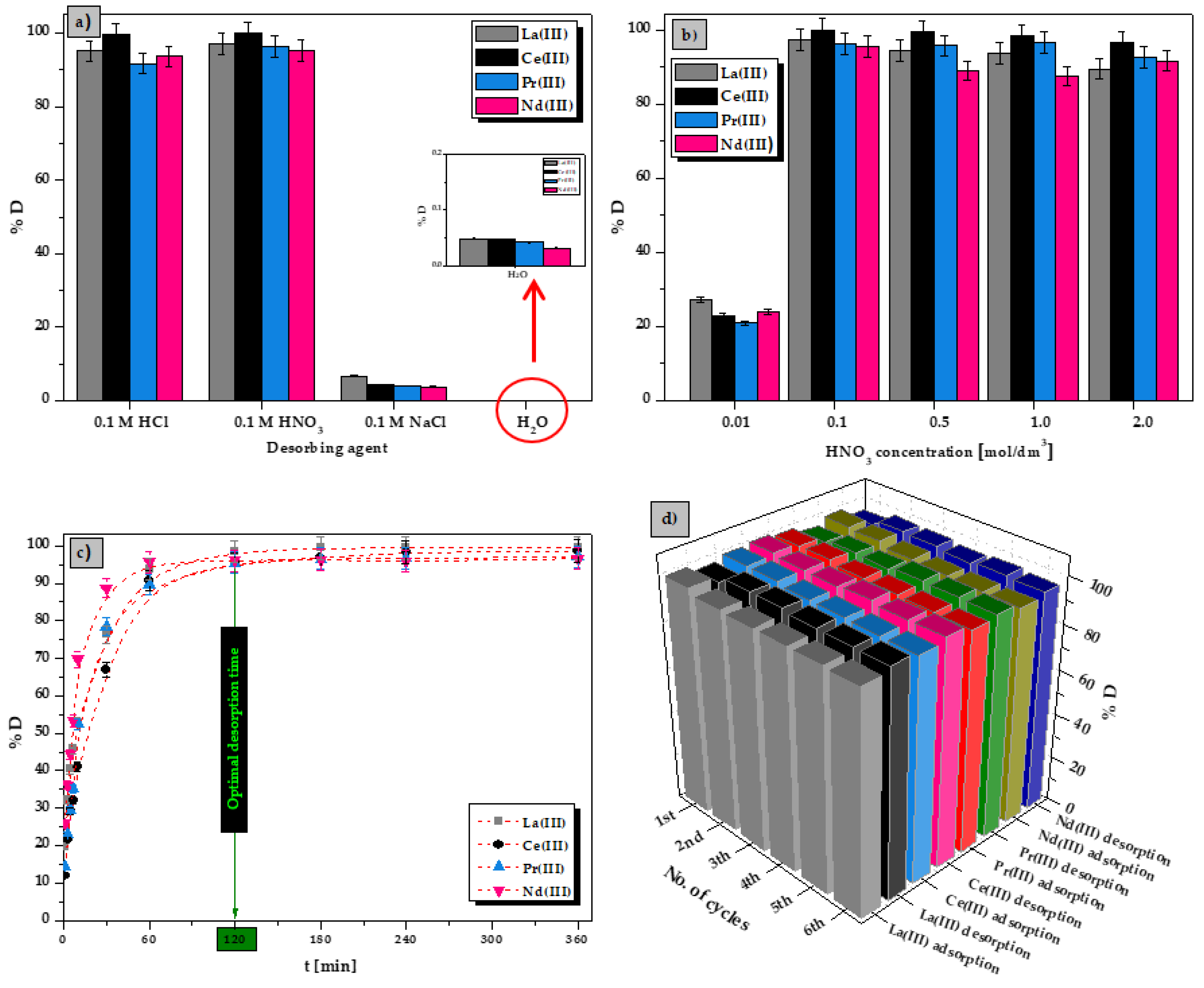3.1. Characterization of the Alginate–Lignin Composite
The infrared spectra (ATR/FT-IR) analysis provides details about the sorbent structure especially the functional groups presence on the sorbent surface and allows to predict possible attachment of metal ions. The comparison of the Fourier transform infrared spectra of the calcium alginate–lignin composite as well as the raw calcium alginate and lignin is presented in
Figure 1a. Additionally, the spectra after the La(III) ions sorption process on the calcium alginate–lignin composite are included in
Figure 1b.
The broad band located in the range of 3700–3000 cm
−1 corresponding to the -OH stretching vibrations of hydroxyl functional groups and also the structural water content was detected in the calcium alginate, lignin as well as the new synthetized calcium alginate–lignin composite samples. In the 2900–3000 cm
−1 range, a -CH stretching band appears for all sorbents. In the calcium alginate spectrum the strong peaks present at 1586 and 1412 cm
−1 correspond to the C-O asymmetric and C-O symmetric stretching vibrations in the COO
− groups, respectively. Additionally, three characteristic bands of alginate located at 1172, 1084 and 1014 cm
−1 were identified as C–O, C–O–C and C–C stretching vibrations [
20,
21]. In the lignin sample, there are many bands in the range of 1000–1700 cm
−1 assigned to the C=O stretching vibrations (1590 cm
−1), C=C stretching of aromatic ring (1510 cm
−1), C–H deformation in –CH
2– and –CH
3 groups as well as C-H aromatic ring vibrations (1350–1450 cm
−1), C–O stretching ring (1268 cm
−1). Some characteristic bands assigned to the C–C, C–O and C=O stretching, aromatic C-H in-plane deformation as well as aromatic C-H in-plane deformation were detected at 1210, 1120 and 1020 cm
−1 [
22,
23]. Bands characteristic of both calcium alginate and lignin appeared in the calcium alginate–lignin composite spectrum which indicates that lignin is effectively incorporated into the alginate structure. The spectra of ALG
5L
1 composite before and after the exposure to La(III), Ce(III), Pr(III), and Nd(III) ions prove a reaction between the carboxyl functional groups and the REEs (
Figure 1b). After the reaction with La(III) ions, the peaks related to the carboxyl groups shifted from 1592 to 1584 cm
−1 and were enhanced at 1416 and 1086 cm
−1. Moreover, after the Ce(III), Pr(III), and Nd(III) ions sorption the peaks of COO
− groups were shifted from 1592 to 1576 cm
−1 for Ce(III) ions, from 1592 to 1580 cm
−1 for Pr(III) ions, and from 1592 to 1578 cm
−1 for Nd(III) ions. These observations indicate that the sorption of REEs using ALG
5L
1 is due to the reaction with carboxyl groups.
The ALG
5L
1 composite beads morphology and topography were analyzed using optical microscopy (OM) and scanning electron microscopy (SEM) both before and after the lanthanum(III) ions sorption process. The obtained images are shown in
Figure 2.
The SEM analysis reveals the ALG
5L
1 composite porosity in the images with different magnifications (
Figure 2). After the La(III) ions sorption, the surface became more wrinkled, rough and porous. Moreover, after the sorption process, the composite beads become more matte (opaque) as shown by the optical microscopy.
In addition, the SEM analysis was made with EDX to get to know the chemical composition of the samples, i.e., elemental identification and their quantitative composition information (
Table 1). The EDX analysis was performed over the areas of around 149 × 149 µm
2 at a beam accelerating voltage equal 20 kV.
Table 3 reports the chemical composition determined by SEM-EDX of the ALG
5L
1 composite before and after the La(III) ions sorption.
It should be noted that carbon, oxygen, and calcium are major constituents in the composite, additionally, there are small amounts of sulphur in the composite from lignin. The trace amounts of chlorine before the sorption process were due to their incomplete removal after the synthesis process. After the sorption process lanthanum appearance confirmed La(III) ions binding on the ALG5L1 surface. It should be mentioned that after the La(III) ions sorption the amount of calcium decreases from 7.96% to 1.00%, which confirms the ion exchange process.
Atomic force microscopy (AFM) was used to collect information about the topographical features of the composite such as morphology and surface roughness. The images shown in
Figure 3 depict the 2D and 3D topographical comparison of the ALG
5L
1 composite before and after the La(III) ions sorption.
The AFM images of the calcium alginate–lignin composite show a relatively smooth surface. As follows from the 3D images the ALG
5L
1 composite (
Figure 3c,d) is characterized by a more uneven surface with major trough features indicating that the surface roughness is increased compared to this composite after the La(III) ions sorption. The sorbent surface roughness is larger before the sorption process but after the sorption the porous structure is filled resulting in a smoother structure. The determined
Ra and
Rq roughness values were 24.8 and 31.3 nm before the La(III) ions sorption and 22.1 and 29.5 nm after the La(III) ions sorption.
The X-ray powder diffraction patterns were analyzed to study the morphology of calcium alginate, lignin, and newly synthetized calcium alginate–lignin composite in more detail. The typical XRD patterns of the samples are shown in
Figure S2.
Two major peaks at 13.16° and 22.38° for alginate and three peaks at 18.32°, 31.78° and 33.86° for lignin were observed as confirmed by the previous studies [
24,
25,
26]. The characteristic peaks for the calcium alginate and lignin were observed in the new composite at 14.88°, 21.29° and 31.96°. All samples were characterized by the broadening in the diffraction spectrum indicating their amorphous nature.
Additionally, the sieve analysis was carried out to measure the particle size distribution of ALG
5L
1 composite. For this purpose, laboratory sieves with the mesh sizes ranging from 900 to 1200 µm were used. The obtained results of the sieve analysis showed that the ALG
5L
1 composite is characterized by mono-dispersity, the prepared beads are uniform in size. Nearly 99% of the composite beads are 1100 µm in size (only 1% of particle size are 1200 µm). This is also confirmed by the images taken using optical microscopy (
Figure 2).
The surface properties of the calcium alginate–lignin composite, i.e., specific surface area, pores diameter, total pores volume as well as micropores volume were analyzed using the surface area analyzer (Quantachrome, Graz, Austria). The specific surface area of the ALG
5L
1 composite beads was measured using the Brunauer–Emmet–Teller (BET) method. The total pore volume of the biosorbents was estimated from the amount adsorbed at
p/
p0 = 0.99. The textural parameters of the ALG
5L
1 composite as well as the raw calcium alginate and raw lignin are presented in
Table S1. The new synthetized calcium alginate–lignin composite possesses the largest specific surface area 8.018 m
2/g compared with the raw calcium alginate (4.707 m
2/g) and raw lignin (1.918 m
2/g). After the calcium alginate modification with lignin, the specific surface area and the pore size distribution of the new ALG
5L
1 composite increased. The calculated pore diameter values of biosorbents in the range of 2.975–6.107 nm indicate the presence of mesopores in their structure.
3.2. Evaluation of the Influence of Different Sorption Conditions on the Sorption Performance
The pH value determines the degree of dissociation of the molecules present in the solution and the functional groups on the sorbents surface. Metal ions in the aqueous solutions occurring in different forms can be adsorb or precipitate on the adsorbent surface. Thus, the metal speciation is one of the important factors affecting the adsorption process. As follows from the speciation graphs provided by Basualto et al. [
27], Bouyer et al. [
28], and Park and Tavlaride [
29], the concentrations of speciation forms metals such as M(OH)
2+, M(OH)
2+, M(OH)
3 or M(OH)
4− at pH < 6 are too low to affect the sorption process of the dominant form M
3+ (M = La
3+, Ce
3+, Pr
3+ or Nd
3+).
To assess the effect of solution pH on the La(III), Ce(III), Pr(III), and Nd(III) ions sorption efficiency on the ALG
5L
1 composite and lignin the experiments in the pH range of 1–7 were conducted, keeping the initial metal ion concentration at 100 mg/dm
3. The obtained results are presented in
Figure 4a,b.
It was noticed that the change of solution pH influences on metal ions sorption. The La(III), Ce(III), Pr(III), and Nd(III) ions sorption does not occur at pH < 1, increases constantly in the rane of pH 2–5, and maintains a high level until pH = 6. In this pH range, the –COOH groups dissociated forming negatively charged –COO
− groups and were the main groups interacting with metal ions. At higher pH values (pH > 6), a decrease in the
qe value was observed which may be due to the formation of metal hydroxides species. The surface of calcium alginate–lignin (ALG
5L
1) composite has the point of zero charge (pH
pzc) at about 5.85 (
Figure 4d). The optimum pH chosen for further sorption studies for the ALG
5L
1 composite was pH equal to 5, at which the
qe values for La(III), Ce(III), Pr(III) and Nd(III) ions were 40.87 mg/g, 41.84 mg/g, 41.08 mg/g and 42.78 mg/g, respectively. On the other hand, the sorption efficiencies of La(III), Ce(III), Pr(III), and Nd(III) ions at pH 5 on the ALG
5L
1 composite were 99.29%, 99.28%, 99.40% and 97.72%, respectively. Comparing the above results to those of raw lignin, the optimum selected pH value was also pH 5 for which the sorption efficiency of La(III), Ce(III), Pr(III) and Nd(III) ions was 60.34%, 46.56%, 47.64% and 38.91%, respectively.
In order to identify whether one mechanism of the sorption process is ion exchange, a parallel study of the kinetics of calcium release from the composite beads was also carried out (
Figure 4c). The results indicate that there is an increase in pH (1 unit increase) during the sorption of La(III) ions on the ALG
5L
1 composite, resulting from the ion exchange of calcium present in the composite structure for lanthanum present in the solution. Additionally, as follows from
Figure 4c, during the sorption of La(III) ions, Ca(II) ions are released from the composite structure, i.e., the concentration of La(III) ions decreases while that of Ca(II) ions increases in the aqueous solution. This confirms that one of the main sorption mechanisms of La(III) ions is ion exchange and the ALG
5L
1 composite behaves as a typical cation exchanger as shown below (where R is the composite structure):
The composite mass plays an important role in the sorption process because it determines the accessibility of active sites on the sorbent and thus the process efficiency. In this study, different amounts of the ALG
5L
1 composite (0.05–0.5 g) were employed to find out the optimal mass.
Figure S3 illustrates the effect of sorbent mass on the La(III), Ce(III), Pr(III), and Nd(III) ions sorption efficiency as well as the sorption capacity of ALG
5L
1 composite.
As the mass of the composite increases from 0.05 to 0.5 g, the number of unoccupied active sites on the sorbent increases, resulting in a decrease in the equilibrium capacity (qe) values. Moreover, the sorption efficiency was almost stable over the entire range of the tested mass and was close to 100% regardless of the sorbed metal ions. The optimum composite mass selected for further sorption studies was 0.05 g, at which the qe values for La(III), Ce(III), Pr(III) and Nd(III) ions were 41.23, 41.84, 41.08 and 41.98 mg/g, respectively. Analogous results were obtained for raw lignin for which, using a mass of 0.05 g, the following sorption capacities were obtained: 22.49 mg/g for La(III), 21.57 mg/g for Ce(III), 19.53 mg/g for Pr(III), and 18.90 mg/g for Nd(III).
The prospective effect of interfering ions on the La(III), Ce(III), Pr(III), and Nd(III) ions sorption process onto the ALG
5L
1 composite was investigated. The adsorption performance values in the presence and absence of any interfering species such as NaNO
3, NaCl, Na
2SO
4, Ni(NO
3)
2, Ni(NO
3)
2, as well as Fe(NO
3)
3 are presented in
Figure 5.
The study revealed that the removal efficiency of La(III), Ce(III), Pr(III), and Nd(III) ions was altered mainly by the presence of Fe(III) ions. The effects of other species was not significant. There is a notable depreciation in the adsorption efficiency towards La(III), Ce(III), Pr(III), and Nd(III) ions due to the existence of interfering species, i.e., Fe(III) ions, more than 50% decrease in the adsorption efficiency of metal ions on the ALG5L1 composite was observed. The ALG5L1 composite showed higher affinity for metal ions in the third oxidation state rather than in the second and first oxidation ones.
3.3. The Thermodynamic, Kinetic, and Isotherm Studies
Table S2 (see Supplementary Materials) presents the obtained thermodynamic parameters for the La(III), Ce(III), Pr(III), and Nd(III) ions sorption onto the ALG
5L
1 composite. The obtained negative values of
ΔG° indicated the thermodynamically feasible spontaneous character of the metal ions sorption onto the ALG
5L
1 composite. Moreover, the
ΔG° values increased with an increase in the temperature, suggesting a greater sorption feasibility at higher temperature. The
ΔH° value was found to be 7.31 kJ/mol for La(III), 7.76 kJ/mol for Ce(III), 6.11 kJ/mol for Pr(III), and 8.45 kJ/mol for Nd(III) indicating the endothermic nature of sorption at 293–333 K. The positive value of
ΔS° ranging from 25.39 to 33.79 kJ/mol·K suggested an increase in randomness or adsorbed species degree of freedom at the solid/aqueous solution interface in the sorption process. A plot of ln(
Kc) vs. 1/
T was found to be linear with the high
R2 values (0.934–0.985). Similar results were obtained for lignin (see
Table S3). The calculated thermodynamic parameters revealed that the La(III), Ce(III), Pr(III) and Nd(III) ion sorption onto lignin had endothermic, spontaneous and more favourable character at higher temperatures.
Studying the influence of temperature on the La(III), Ce(III), Pr(III), and Nd(III) ions sorption process efficiency on the ALG5L1 composite, an increase in the equilibrium capacity values with the increasing temperature from 293 to 333 K was observed. In detail, the equilibrium capacities increased as follows: 105.05 to 109.56 mg/g for La(III), 93.83 to 97.97 mg/g for Ce(III), 92.99 to 97.98 mg/g for Pr(III) as well as 96.28 to 98.68 mg/g for Nd(III). This can be attributed to the increased kinetic energy of the molecules or pore diffusion rate.
The mathematical models used to describe the sorption kinetics included the pseudo-first order (PFO), the pseudo-second order (PSO), the intraparticle diffusion (IPD), the Boyd and the Dumwald–Wagner (DW) models. The La(III) ions sorption results from the kinetic studies are given in
Table 1. The linear fitting of the kinetic models for La(III) ions sorption on the ALG
5L
1 composite is illustrated in
Figure 6. On the other hand, the kinetic results for the Ce(III), Pr(III), and Nd(III) ions sorption are presented in the
Supplementary Materials (Figures S4–S6). The all kinetic parameters presented in
Table 1 (also
Tables S4–S6) were determined from the slope and intercept of the straight lines in the plot of log(
qe-
qt) vs.
t for the pseudo-first order kinetic model,
t/
qt vs.
t for the pseudo-second order kinetic model,
qt vs.
t1/2 for the Weber-Morris intraparticle diffusion model,
Bt vs.
t for the Boyd model, and log(1-
F2) vs. t for the Dumwald–Wagner model, respectively.
Table 1.
Calculated kinetic parameters for the La(III) ions sorption onto the ALG5L1 composite a.
Table 1.
Calculated kinetic parameters for the La(III) ions sorption onto the ALG5L1 composite a.
| Kinetic Model | Equations | Parameter | ALG5L1 |
|---|
| C0 [mg/dm3] | 25 | 50 | 100 | 150 | 200 |
|---|
| | | qexp
[mg/g] | 10.64 | 20.76 | 44.75 | 64.86 | 81.89 |
| PFO | | q1
[mg/g] | 10.21 | 17.61 | 37.99 | 48.42 | 68.67 |
| | k1 × 10−2
[1/min] | 3.94 | 1.59 | 0.74 | 0.34 | 0.26 |
| | R2 | 0.995 | 0.991 | 0.970 | 0.912 | 0.963 |
| PSO | | q2
[mg/g] | 11.42 | 22.35 | 48.03 | 67.10 | 85.75 |
| k2 × 10−2 [g/mg∙min] | 0.36 | 0.15 | 0.042 | 0.021 | 0.010 |
| | h
[mg/g·min] | 0.47 | 0.76 | 0.95 | 0.96 | 0.72 |
| | R2 | 0.996 | 0.998 | 0.999 | 0.998 | 0.992 |
| IPD | | ki1
[mg/g·min1/2] | 1.05 | 2.08 | 3.11 | 3.41 | 4.07 |
| | | C1 | 0.07 | 0.18 | 0.55 | 0.94 | 1.04 |
| | | R2 | 0.959 | 0.975 | 0.974 | 0.932 | 0.867 |
| | | ki2
[mg/g·min1/2] | 1.00 | 1.79 | 2.69 | 2.58 | 2.99 |
| | | C2 | 0.64 | 1.35 | 2.15 | 8.17 | 4.01 |
| | | R2 | 0.883 | 0.982 | 0.933 | 0.964 | 0.978 |
| | | ki3
[mg/g·min1/2] | 0.0007 | 0.092 | 0.25 | 0.48 | 1.24 |
| | | C3 | 10.63 | 18.84 | 37.51 | 46.67 | 35.60 |
| | | R2 | 0.599 | 0.857 | 0.751 | 0.955 | 0.982 |
| Boyd | | B | 13.38 | 5.10 | 3.00 | 2.53 | 1.99 |
| | | R2 | 0.996 | 0.995 | 0.988 | 0.999 | 0.999 |
| DW | | K | 0.038 | 0.014 | 0.006 | 0.003 | 0.002 |
| | | R2 | 0.996 | 0.997 | 0.991 | 0.959 | 0.999 |
Figure 6 (also
Figures S4–S6) plot the kinetic profiles of La(III), Ce(III), Pr(III), and Nd(III) ions sorption using ALG
5L
1 as a sorbent. It can be clearly that the sorption process rate depends on the initial concentration of metal ions (
Figure 6a). An increase in the initial concentration from 25 to 200 mg/dm
3 resulted in the sorption process rate decrease and hence an increase in the time to establish the sorption equilibrium. For example, 50% La(III) ions sorption for the metal concentrations in the range of 25–200 mg/dm
3 required the times ranging from 15 to 240 min, respectively. The Ce(III), Pr(III), and Nd(III) ions removal has a similar trend. Depending on the initial La(III), Ce(III), Pr(III), and Nd(III) solution concentrations, the sorption equilibrium state was established after 120 min for 25–50 mg/dm
3, 480 min for 100 mg/dm
3, and 1440 min for 150 and 200 mg/dm
3.
As follows from
Table 1 (also
Tables S4–S6), the correlation coefficients (
R2) for the PFO model are not high in the whole La(III), Ce(III), Pr(III), and Nd(III) ions concentration range. Moreover, the evaluated
q1 values calculated from the PFO equation differed from the experimental
qexp values which means that the PFO kinetic model is not suitable to represent the sorption process. Considering the results obtained for the PSO model, the
R2 values are large throughout the metal concentration range and tend towards unity (0.992–0.999). Moreover, the estimated
q2 values calculated from the PSO equation were similar to the experimental
qexp values. Additionally, the plots of the PSO kinetic model (
Figure 6c and
Figures S4–S6c) were rectilinear over the entire range and thus, the pseudo second-order model fits the data most satisfactorily. The initial rate of adsorption,
h, determined for the pseudo-second order model increased when the increasing initial metal ions concentration from 25 to 150 mg/dm
3 and after that decreased maybe due to the high competition of metal ions for the available active sites of composites which leads also to lower sorption rates.
As the pseudo-first and pseudo-second order kinetic models cannot identify the diffusion mechanism, the Weber-Morris intraparticle diffusion, the Boyd, and the Dumwald-Wagner kinetic models were applied in order to determine the participation of the diffusion process in the La(III), Ce(III), Pr(III), and Nd(III) ions sorption using the ALG
5L
1 composite. The Weber-Morris plot (
Figure 6d) shows the multi-stages of sorption process as the fitted experimental data are not linear as well as the plot does not pass through the origin. This implies the existence of three stages that contribute to the sorption process and intraparticle diffusion is not a sole rate limiting step [
30]. The first one is related to the adsorbate diffusion from the solution to the outer surface of the adsorbent. The next stage involves the slow adsorbate movement from the boundary layer to the sorbent surface (called film diffusion), and the third stage is related to the adsorbate movement to the adsorbent pore and after that adsorption equilibrium is achieved [
31]. The calculated intraparticle diffusion values of
ki1,
ki2,
ki3 and
C1,
C2,
C3 differ enormously, and increase in the order
ki1 >
ki2 >
ki3, and
C1 >
C2 >
C3. Moreover, both
ki and
Ci values increase with the increasing initial La(III), Ce(III), Pr(III), and Nd(III) concentrations, the higher the
Ci values, the greater the influence of the boundary layer on the sorption process. For the Boyd kinetic model, the plot intercept was not 0 but was close to 0 for all initial metal concentrations, it suggests that the predominant limiting step of sorption rate is intraparticle diffusion. The Dumwald–Wagner kinetic plots are linear with high correlation coefficients (
R2 values were in the range 0.959–0.999) pointing out to the applicability of this kinetic model. The diffusion rate constants for the La(III) diffusion inside the ALG
5L
1 composite were 0.002–0.038 1/min and decrease with the increasing initial metal concentration.
The sorption process kinetics of La(III), Ce(III), Pr(III) and Nd(III) ions was also determined for raw lignin (
Figure S7 and Table S7). The sorption equilibrium state was achieved after 120 min. The kinetic parameters of the above metal ions on raw lignin were best described by the pseudo-second order kinetic model. This is confirmed by the correlation coefficient value close to unity (
R2 = 0.999–1.000) obtained for all systems. In addition, the q
2 values obtained from the pseudo-second order kinetic model calculations were close to the experimental data (
qexp). In the case of k
2 and h coefficient values, there was an increasing trend of these parameters in the following series: La(III) > Pr(III) > Nd(III) > Ce(III).
The isotherms give insight into the maximum sorption capacities or the amount of sorbent needed to remove a given mass of metal ion from an aqueous system under the process conditions. The interpretation of the obtained isotherms through the determination of equilibrium parameters also provides valuable information on the nature of the interactions between the metal ions and the sorbent as well as the mechanism of the process taking place.
In the sorption isotherm studies, the Langmuir, Freundlich, Temkin, and Dubinin–Radushkevich isotherms were employed to describe the equilibrium sorption process and to fit the experimental data. The isotherm parameters for the La(III) ions sorption are given in
Table 2 (for the Ce(III), Pr(III) and Nd(III) ions sorption in the
Supplementary Materials, Table S8). Moreover, the nonlinear fitting of isotherm models for La(III), Ce(III), Pr(III) and Nd(III) ions is presented in
Figure 7.
Table 2.
Calculated isotherm parameters for the La(III) ions sorption onto the ALG5L1 composite b.
Table 2.
Calculated isotherm parameters for the La(III) ions sorption onto the ALG5L1 composite b.
Isotherm
Model | Equations | Parameters | ALG5L1 |
|---|
| T [K] | 293 | 313 | 333 |
|---|
| | | qexp
[mg/g] | 105.05 | 107.95 | 109.56 |
| Langmuir | | qm
[mg/g] | 104.83 | 107.72 | 109.24 |
| | | KL
[dm3/mg] | 0.19 | 0.25 | 0.28 |
| | | R2 | 0.996 | 0.998 | 0.998 |
| | | χ2 | 0.043 | 0.029 | 0.029 |
| Freundlich | | KF
[mg/g] | 39.97 | 43.14 | 43.56 |
| | | n | 5.39 | 5.50 | 5.44 |
| | | R2 | 0.944 | 0.954 | 0.956 |
| | | χ2 | 0.682 | 1.134 | 1.286 |
| Temkin | | A × 103
[dm3/g] | 1.25 | 2.09 | 2.03 |
| | | B
[J/mol] | 7.69 | 7.69 | 7.85 |
| | | R2 | 0.973 | 0.978 | 0.974 |
| | | χ2 | 0.472 | 0.338 | 0.338 |
| Dubinin–Raduschkevich | | Xm × 10−3
[mg/g] | 2.17 | 2.24 | 2.28 |
| | | Β × 10−3
[mol2/kJ2] | 1.25 | 1.20 | 1.20 |
| | | E
[kJ/mol] | 19.98 | 20.44 | 20.41 |
| | | R2 | 0.963 | 0.979 | 0.977 |
| | | χ2 | 0.057 | 0.006 | 0.009 |
Table 3.
EDX analysis results of ALG5L1 composite before and after the La(III) ions sorption.
Table 3.
EDX analysis results of ALG5L1 composite before and after the La(III) ions sorption.
| | Element | Wt% | At% |
|---|
| Chemical composition of ALG5L1 composite before the La(III) ions sorption |
![Materials 15 00944 i001]() | C K | 43.03 | 52.39 |
| O K | 48.76 | 44.59 |
| S K | 0.17 | 0.08 |
| Cl K | 0.09 | 0.04 |
| Ca K | 7.96 | 2.91 |
| Total | 100.00 | 100.00 |
| Chemical composition of ALG5L1 composite after the La(III) ions sorption |
![Materials 15 00944 i002]() | C K | 42.27 | 55.28 |
| O K | 43.60 | 42.77 |
| S K | 0.17 | 0.08 |
| Ca K | 1.00 | 0.40 |
| La L | 12.96 | 1.47 |
| Total | 100.00 | 100.00 |
It can be clearly seen from
Figure 7 that the isotherm fitting of the La(III), Ce(III), Pr(III), and Nd(III) ions sorption on the ALG
5L
1 composite is the most compatible with the Langmuir isotherm compared with the Freundlich, Temkin and Dubinin–Raduschkevich ones. The correlation coefficients for the Langmuir isotherm fitting were 0.996, 0.998, 0.998 for the La(III) ions sorption at 293, 313 and 333 K, respectively (see
Table 2). For the Ce(III), Pr(III), and Nd(III), the
R2 values for the Langmuir isotherm were in the range of 0.997–0.998, 0.993–0.997 and 0.993–0.996, respectively (see
Table S8). The obtained correlation coefficients close to 1 reveal that the monolayer chemical adsorption plays a main role in the sorption process of La(III), Ce(III), Pr(III) and Nd(III) ions on the ALG
5L
1 composite. Moreover, a good fit of a given isotherm model is indicated by the chi-square (
Χ2) error value, which should be less than 1. Low
Χ2 values were obtained for the Langmuir isotherm model (0.029–0.043 for La(III), 0.005–0.024 for Ce(III), 0.050–0.171 for Pr(III), and 0.073–0.157 for Nd(III)). The maximum monolayer adsorption capacity of ALG
5L
1 composite for La(III), Ce(III), Pr(III) and Nd(III) increased with the increasing temperature (from 293 to 333 K) and were 109.24, 97.6, 97.30 and 97.72 mg/g at 333 K, respectively. According to the
KL parameter determined for the Langmuir model, its value increases with the increasing temperature indicating higher affinity of the sorbent for metal ions. Good fits were also obtained for the Temkin model which assumes that the entire adsorbent surface is not homogeneous from an energetic point of view [
32]. The Dubinin–Radushkevich isotherm allowed for the determination of the parameter
E defining the mean free energy, which made it possible to determine the nature of the sorption process-chemisorption or physisorption [
33]. The values of parameter
E for metal ions sorption on the ALG
5L
1 composite were in the range of 19.98–20.44 kJ/mol for La(III), 16.98–18.31 kJ/mol for Ce(III), 16.44–17.82 kJ/mol for Pr(III), and 15.90–18.57 kJ/mol for Nd(III) which indicates the chemical nature of the sorption process (surface complexation or ion exchange mechanism) [
34]. Based on the results given in
Table 2 (also
Table S8), the adsorption capacity of the ALG
5L
1 composite towards the metal ions (La(III), Ce(III), Pr(III), and Nd(III)) is follows: La(III) > Nd(III) > Pr(III) ≈ Ce(III). Based on the
R2, and
Χ2 values, the best fitting isotherm adsorption order is: Langmuir > Temkin > Dubinin–Raduschkevich > Freundlich for the ALG
5L
1 composite. Moreover, according to the isotherm modelling data for the La(III), Ce(III), Pr(III), and Nd(III) ions sorption on raw lignin (see
Table S9 and Figure S8) a similar fitting isotherm model to the above one was found. Considering the maximum monolayer adsorption capacities obtained for raw lignin (
Table S9), the affinity series for the metal ions was as follows: Pr(III) (41.89 mg/g) > La(III) (39.08 mg/g) > Ce(III) (38.89 mg/g) > Nd(III) (31.00 mg/g). The above values of the maximum monolayer adsorption capacities for raw lignin were significantly smaller than those for the new synthetized calcium alginate–lignin composite one.
3.5. Desorption and Reusability Studies
The desorption efficiency of La(III), Ce(III), Pr(III), and Nd(III) ions from the ALG
5L
1 composite was calculated as the ratio between the metal ions desorbed amount and the metal ions adsorbed one. First, the best desorbent agent was selected. For this purpose, four desorbing agents were used for the study: 0.1 M HCl, 0.1 M HNO
3, 0.1 M NaCl and H
2O. As illustrated in
Figure 8a, in the case of HCl and HNO
3, desorption efficiencies for La(III), Ce(III), Pr(III), and Nd(III) ions were very similar at around 93–99%. In contrast, NaCl could desorb maximum only 7% of the above metal ions. Distilled water was not an effective desorbing agent
(%D below 0.1%). So HNO
3 was chosen as the best desorbing agent for metal ions. The HNO
3 concentrations of 0.01, 0.1, 0.5, 1.0, and 2.0 M were tested for elution of adsorbed La(III), Ce(III), Pr(III), and Nd(III) ions. It can be seen in
Figure 8b that the desorption efficiency for the above metal ions initially increased with the increasing HNO
3 concentration. However, insignificant changes of desorption efficiency were observed at the HNO
3 concentrations over 0.1 M. Only for the desorption of Nd(III) ions, a slight decrease in
%D was observed with the increasing HNO
3 concentration from 0.5 to 2 M. Therefore, 0.1 M HNO
3 with over 95% desorption efficiency was chosen as the optimal desorbing agent in terms of economy and efficiency. Moreover, the desorption time was a very significant parameter in batch processes.
Figure 8c presents that the desorption efficiency for La(III), Ce(III), Pr(III), and Nd(III) ions increased with time. The desorption process was completed within 120 min.
Regeneration aspect of the sorption process is very essential in terms of its cost-effectiveness development by recycling the sorbent for example in the multiple cycles reuse studies. In order to scrutinize regeneration abilities for the ALG
5L
1 composite, consecutive adsorption-desorption cycles were repeated six times using the same sorbent. As shown in
Figure 8d, the removal efficiencies of La(III), Ce(III), Pr(III), and Nd(III) ions for the recycled ALG
5L
1 composite were maintained at 95% even in the 6th cycle. Reusability studies proved that the new synthetized calcium alginate–lignin composite is a highly renewable sorbent.
